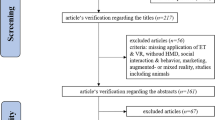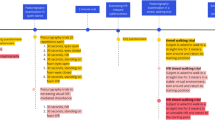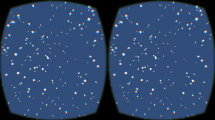Abstract
Virtual reality has been extensively studied for applications in rehabilitation. With the development of active video games, these commercial products can also be considered for inclusion in a patient’s rehabilitation program. In this study, the Sony EyeToy ® and PlayStation 2 ® were used with the AntiGrav™ game to evaluate the user’s head movement actions. The game required lateral head, body, and arm movements. Over the course of 9 sessions of game play, average and maximum head excursions remained constant. However, the frequency of head movement increased over the sessions. The results suggest that the video game could be used for postural balance rehabilitation through head movements, and their effect on the vestibular system. Future work will evaluate how such vestibular exercise, and an increase in head movement frequency over training sessions can support postural balance improvements.



Similar content being viewed by others
Abbreviations
- VE:
-
Virtual environment
- VR:
-
Virtual reality
- RMS:
-
Root mean square
- FFT:
-
Fast Fourier transform
References
Bisson E, Contant B, Sveistrup H, Lajoie Y (2007) Functional balance and dual-task reaction times in older adults are improved by virtual reality and biofeedback training. Cyberpsychol Behav 10(1):16–23
Chen YP, Kang LJ, Chuang TY, Doong JL, Lee SJ, Tsai MW, Jeng SF, Sung WH (2007) Use of virtual reality to improve upper-extremity control in children with cerebral palsy: a single-subject design. Phys Ther 87(11):1441–1457
Deutsch JE, Borbely M, Filler J, Huhn K, Guarrera-Bowlby P (2008) Use of a low-cost, commercially available gaming console (Wii) for rehabilitation of an adolescent with cerebral palsy. Phys Ther 88(10):1196–1207
Di Fabio RP, Anderson JH (1993) Effect of sway-referenced visual and somatosensory inputs on human head movement and postural patterns during stance. J Vestib Res 3(4):409–417
Emery CA, Cassidy JD, Klassen TP, Rosychuk RJ, Rowe BH (2005) Effectiveness of a home-based balance-training program in reducing sports-related injuries among healthy adolescents: a cluster randomized controlled trial. Can Med Assoc J 172(6):749–754
Eng JJ, Pang MYC, Ashe MC (2008) Balance, falls and bone health: role of exercise in reducing fracture risk after stroke. J Rehabil Res Dev 45(2):297–314
Flynn S, Palma P, Bender A (2007) Feasibility of using the Sony Playstation 2 gaming platform for an individual poststroke: a case report. J Neurol Phys Ther 31:180–189
Furtado EC, Ramos PD, de Araujo CGS (2009) Blood pressure measurement during aerobic exercise: subsidies for cardiac rehabilitation. Arq Brasil Cardiolog 93(1):45–52
Gervasi O, Magni R, Zampolini M (2010) Nu!RehaVR: virtual reality in neuro tele-rehabilitation of patients with traumatic brain injury and stroke. Virtual Real 14(2):131–141
Hurkmans E, van der Giesen FJ, Vliet Vlieland TP, Schoones J, Van den Ende EC (2009) Dynamic exercise programs (aerobic capacity and/or muscle strength training) in patients with rheumatoid arthritis. Cochrane Database Syst Rev 4:CD006853
Ivey FM, Hafer-Macko CE, Macko RF (2008) Task-oriented treadmill exercise training in chronic hemiparetic stroke. J Rehabil Res Dev 45(2):249–260
Keshner AE, Kenyon VR (2004) Using immersive technology for postural research and rehabilitation. Asst Technol 16(1):27–35
Levac D, Pierrynowski MR, Canestraro M, Gurr L, Leonard L, Neeley C (2010) Exploring children’s movement characteristics during virtual reality video game play. Hum Mov Sci 29(6):1023–1038
Loke L, Larssen AT, Robertson T, Edwards J (2007) Understanding movement for interaction design: frameworks and approaches. Pers Ubiquit Comput 11(8):691–701
Lotan M, Yalon-Chamovitz S, Weiss PL (2009) Improving physical fitness of individuals with intellectual and developmental disability through a Virtual Reality Intervention Program. Res Dev Disabil 30(2):229–239
Macko RF, Benvenuti F, Stanhope S, Macellari V, Taviani A, Nesi B, Weinrich M, Stuart M (2008) Adaptive physical activity improves mobility function and quality of life in chronic hemiparesis. J Rehabil Res Dev 45(2):323–338
Maki BE, McIlroy WE, Fernie GR (2003) Change-in-support reactions for balance recovery. IEEE Eng Med Biol Mag 22(2):20–26
McConville KMV, Virk S (2012) Evaluation of an electronic video game for improvement of balance. Virtual Real 16(4):315–323
Mille ML, Johnson ME, Martinez KM, Rogers MW (2005) Age-dependent differences in lateral balance recovery through protective stepping. Clin Biomech 20:607–616
Milosevic M, McConville KMV, Masani K (2011) Arm movement improves performance in clinical balance and mobility tests. Gait Posture 33(3):507–509
Norré ME, Beckers AM (1988) Vestibular Habituation Training: specificity of Adequate Exercise. Arch Otolaryngol Head Neck Surg 114(8):883–886
Rand D, Kizony R, Weiss PL (2008) The Sony PlayStation II EyeToy: low-cost virtual reality for use in rehabilitation. J Neurol Phys Ther 32(4):155–163
Rogers MW, Mille ML (2003) Lateral stability and falls in older people. Exerc Sport Sci Rev 31:182–187
Suárez H, Suárez A, Lavinsky L (2006) Postural adaptation in elderly patients with instability and risk of falling after balance training using a virtual-reality system. Int Tinnitus J 12(1):41–44
Sveistrup H, Thornton M, Bryanton C, McComas J, Marshall S, Finestone H, McCormick A, McLean J, Brien M, Lajoie Y, Bisson E (2004) Outcomes of intervention programs using flatscreen virtual reality. In: Proceedings of the 26th IEEE engineering in medicine and biology conference, vol 2, IEEE Press, San Francisco, CA, 1–5 Sept, pp 4856–4858
Weiss P, Rand D, Katz N, Kizony R (2004) Video capture virtual reality as a flexible and effective rehabilitation tool. J Neuro Eng Rehabil 1(1):1–12
Wikstrom EA, Naik S, Lodha N, Cauraugh JH (2009) Balance capabilities after lateral ankle trauma and intervention: a meta-analysis. Med Sci Sports Exerc 41(6):1287–1295
Yavuzer G, Senel A, Atay MB et al (2008) “Playstation eyetoy games” improve upper extremity-related motor functioning in subacute stroke: a randomized controlled clinical trial. Eur J Phys Rehabil Med 44:1–8
Acknowledgments
We are grateful to Dr. Ken Norwich at the University of Toronto for his endless support and encouragement. We also thank Sumandeep Virk for her assistance with the data collection. We thank Lisa D’Alessandro at the University of Toronto, David Michael Mravyan of Elmedex Inc. in Toronto, and Chih-Chuan (Leo) Kant for their assistance. We acknowledge the Natural Sciences and Engineering Research Council of Canada (NSERC) for supporting this work.
Author information
Authors and Affiliations
Corresponding author
Rights and permissions
About this article
Cite this article
McConville, K.M.V., Milosevic, M. Active video game head movement inputs. Pers Ubiquit Comput 18, 253–257 (2014). https://doi.org/10.1007/s00779-013-0662-2
Received:
Accepted:
Published:
Issue Date:
DOI: https://doi.org/10.1007/s00779-013-0662-2




